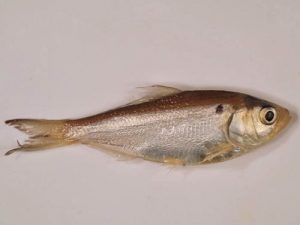
Staff at Arkansas Game and Fish Commission (AGFC) hatcheries throughout the state are busy with threadfin shad stocking efforts, which should improve future fishing conditions for anglers.
More than 4 million threadfin shad have been raised in hatchery locations and nursery ponds throughout the year, and most of those shad have been released into Arkansas lakes in the last month.
Threadfin shad are a favorite forage of many game fish such as bass, walleye, and crappie. While plentiful in many lakes, these important forage species can be in short supply if the predator/prey relationship in a body of water is thrown out of balance.
“We often hear people ask for increased stockings of largemouth bass, crappie and other sport fish, but in truth, most lakes that have good habitat in Arkansas have healthy bass spawns that can produce more fingerling bass in a lake than we could in our entire hatchery system. By stocking threadfin shad in lakes where we believe forage levels are low, we’re trying to help by adding to the food in the lake” according to Ben Batten, AGFC Chief of Fisheries.
Raising forage species is not new for AGFC hatcheries. Fathead minnows and golden shiners are raised to feed fish in nursery ponds and occasionally stock in smaller bodies of water.
Bluegill and redear sunfish also are raised in hatcheries for anglers but also are important food sources for large predator fish. Shad are a relatively new challenge for the hatcheries to tackle.
Last winter, AGFC hatcheries brought in 775 pounds of shad to use as brood stock to begin this season. By the time the last shad was stocked, more than 4 million fish had been raised to supply lakes throughout the state.
“We stocked shad in lakes as large as Bull Shoals, Greers Ferry and Beaver Lake to as small as Terre Noire Lake on (Rick Evans) Grandview (Prairie) WMA and Mallard Lake near Manilla,” said Tommy Laird, AGFC Assistant Chief of Fish Culture. “Maumelle, Hinkle, Ashbaugh, Cargile, Barnett, Columbia, Sugarloaf, Lake Charles, Lower Lake Hogue and South Fork Lake on Grandview also saw shad stockings this year. DeGray was our highest priority for any surplus fish we produced as well.”
Highland impoundments such as Beaver, Maumelle and Greers Ferry can be very infertile, which causes slow growth rates in fish. The boost to the food chain through the stockings can help those lakes.
The last of the shad stockings was completed just as the state experienced a string of frosty mornings.
The agency is keeping a supply of adult threadfin shad broodstock in outdoor ponds or in indoor tanks for next year’s production.
source: Arkansas Game and Fish Commission